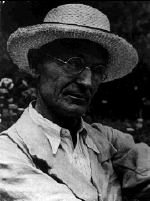 | ...So that's it, thought I. They've disfigured this good old wall with an electric sign. Meanwhile I deciphered one or two of the letters as they appeared again for an instant; but they were hard to read even by guess work, for they came with very irregular spaces between them and very faintly, and then abruptly vanished. Whoever hoped for any result from a display like that was not very smart. He was a Steppenwolf, poor fellow. Why have his letters playing on this old wall in the darkest alley of the Old Town on a wet night with not a soul passing by, and why were they so fleeting, so fitful and illegible? But wait, at last I succeeded in catching several words on end. They were:
MAGIC THEATERENTRANCE NOT FOR EVERYBODY
I tried to open the door, but the heavy old latch would not stir. The display too was over. It had suddenly ceased, sadly convinced of its uselessness. I took a few steps back, landing deep into the mud, but no more letters came. The display was over. For a long time I stood waiting in the mud, but in vain.
Then, when I had given up and gone back to the alley, a few colored letters were dropped here and there, reflected on the asphalt in front of me. I read:
FOR MADMEN ONLY!
--from Steppenwolf
The German-Swiss writer Hermann Hesse, b. Calw, Germany, July 2, 1877, d. Aug. 9, 1962, was awarded the Nobel Prize for literature in 1946. Determined by the age of 13 "to be a poet or nothing," Hesse at first wrote derivative, romantic poems and stories of little merit. In his earliest novels, Peter Camenzind (1904; Eng. trans., 1961) and Beneath the Wheel (1906; Eng. trans., 1968), which expressed his long-smoldering resentment of his pious and repressive upbringing, he pulled himself out of the rut and won success.
The first phase of his writing, which began with the neoromantic treatment of the artist as a social outcast, ended with the realistic Rosshalde (1914; Eng. trans., 1970). At the beginning of World War I, the strain of his pacifist beliefs and domestic crises led him to undertake psychoanalysis with a follower of Carl Gustav Jung. Jungian psychology gave his work a new dimension;Demian (1919; Eng. trans., 1923), Siddhartha (1922; Eng. trans., 1951), and Steppenwolf (1927; Eng. trans., 1929) also reveal the influence of Nietzsche, Dostoyevsky, Spengler, and Buddhist mysticism. These novels are based on the conviction that Western civilization is doomed and that man must express himself in order to find his own nature. A third phase began in 1930. Narziss und Goldmund (1930; trans. as Death and the Lover, 1932) balances the artist's rebellion against the hierarchic continuity of social behavior. In Journey to the East (1932; Eng. trans., 1956) and The Glass Bead Game (1943; Eng. trans., 1957) the quest for freedom conflicts with tradition and leads to personal sacrifice suffused with optimism.
Hesse did not write any novels after 1943 but continued to publish essays, letters, poems, reviews, and stories. From 1912 he lived in Switzerland, of which he became a naturalized citizen in 1923. Hesse's novels became immensely popular during the 1950s in the English-speaking world, where their criticism of bourgeois values and interest in Eastern religious philosophy and Jungian psychology echoed the preoccupations of the younger generation.
G. W. Field
Bibliography: Boulby, Mark, Hermann Hesse: His Mind and Art (1967); Field, George W., Hermann Hesse (1970); Freedman, Ralph, Hermann Hesse: Pilgrim of Crisis, A Biography(1978); Mileck, Joseph, Hermann Hesse: Biography and Bibliography (1977) and Hermann Hesse and His Critics (1958); Stelzig, E.L., Hermann Hesse's Fictions of the Self (1988); Ziolkowski, Theodore, The Novels of Hermann Hesse (1965) and, as ed., Hermann Hesse: A Collection of Critical Essays (1973).
Text Copyright © 1993 Grolier Incorporated
Homepages, Biographies, Bibliographies
Quotes
Articles, Essays, Reviews
Mailing List, Newsgroup
Press-Gopher Links
|



No comments:
Post a Comment